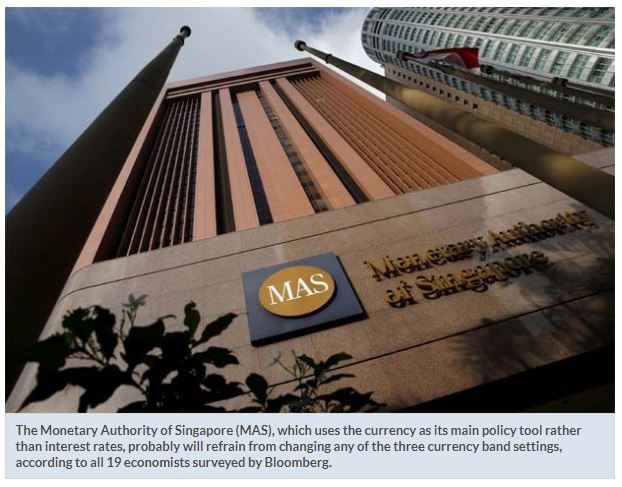Singapore central bank to let fiscal measures do the job
SINGAPORE: Singapore’s central bank is likely to keep monetary policy unchanged as it allows fiscal measures to do the heavy lifting in getting the city-state’s economy back on track.
The Monetary Authority of Singapore (MAS), which uses the currency as its main policy tool rather than interest rates, probably will refrain from changing any of the three currency band settings, according to all 19 economists surveyed by Bloomberg.
The MAS – which typically makes policy decisions twice a year, in April and October – took the unprecedented step in its last announcement of lowering the midpoint of the currency band and reducing the slope to zero. That meant it would allow for a weaker exchange rate to head off deflation and support the export-reliant economy.
Since then, the economy has plunged into recession amid the pandemic and the government has unleashed billions of dollars of stimulus to save businesses and jobs.
The city-state is slowly starting to shake off the impact of mobility restrictions and exports have continued to gain, but the recovery is likely to be a slow one as international travel restrictions remain and global demand stays weak.
The government has forecast a 5%-7% contraction in the economy this year, the worst since independence more than a half-century ago, and may revise that estimate when the Trade and Industry Ministry releases advance third-quarter figures today.
Analysts project gross domestic product to have rebounded an annualised 33.5% on a quarterly basis in the three months through September, while declining 6.8% from a year earlier, Bloomberg survey data show.
Here’s a look at what’s expected in the central bank’s statement, to be released today:
> Policy band
The MAS guides the local dollar against a basket of currencies and adjusts the pace of appreciation or depreciation by changing the slope, width and centre of a currency band. It doesn’t disclose details of the basket, the band or the pace of appreciation or depreciation.
By leaving the policy untouched, the MAS would be signaling that officials are satisfied with the path of the currency – at a time when the US dollar has been on a weakening path.
> Recovery path
The MAS has given support to financial markets and borrowers, but allowed fiscal authorities to take the lead in cushioning the economic blow of the pandemic.
The government has pledged about S$100bil in stimulus so far this year on measures such as wage subsidies, digital transformation initiatives, re-skilling operations and cash grants. It plans to finance a large chunk of that from past reserves.
“Growth and inflation are past their troughs seen in the second quarter, ” Maybank Kim Eng Research Ltd economists Chua Hak Bin and Ju Ye Lee said in an Oct 5 report. “But the recovery is sluggish and more U-shaped than V, dampened by strict border controls, social distancing rules and foreign worker shortages.”
> Inflation Outlook
Consumer prices have contracted for five consecutive months already, dropping 0.4% in August from a year earlier, with the MAS’s core measure falling 0.3%. The central bank’s most recent forecast is for both measures to remain within a range of -1% to 0% for this year. If MAS officials foresee a potential change in subdued commodity prices, or in labor-market conditions that have been particularly weak, that could mean a revised forecast range. — Bloomberg


 English
English




